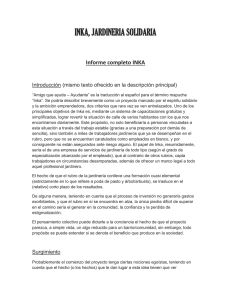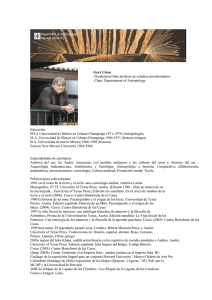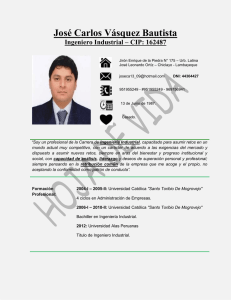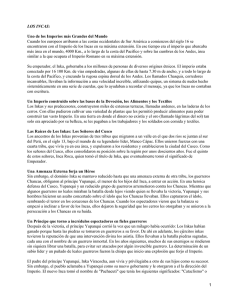activity guide guía de actividades
Anuncio
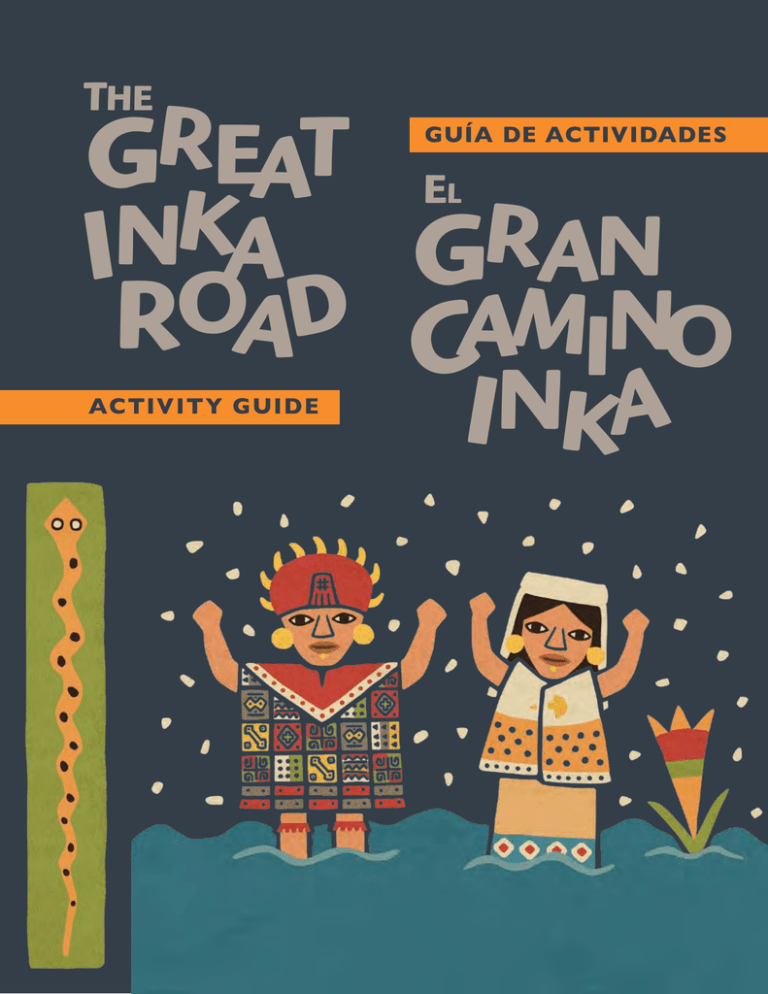
The r G eat E k r n I a G an Road Camino I nka GUÍA DE ACTIVIDADES l ACTIVITY GUIDE Welcome to the National Museum of the CREATION STORY American Indian. Use this guide to explore the Inka Empire and its legacy through STEAM-focused activities: Science, Technology, Engineering, Arts, and Mathematics. This guide supplements the exhibition The Great Inka Road: Engineering an Empire. It is designed for children under 10. Inti, Father Sun, sent his children, Manco Capac and Mama Ocllo, to bring order to the world. Inti told them to walk until their golden staff sank into the ground. There, a great city would rise. That city was Cusco, capital of the Inka Empire. Manco and Mama’s journey to Cusco was the first Inka Road. Bienvenido al Museo Nacional del Indígena HISTORIA DE L A CREACIÓN Americano. Use esta guía para explorar el Imperio Inka y su legado a través de actividades conforme al plan STEAM (sigla en inglés por Ciencia, Tecnología, Ingeniería, Artes y Matemáticas). Esta guía es un complemento de la exposición El Gran Camino Inka: Construyendo un Imperio. Fue diseñada para niños menores de 10 años. El Inti, Padre Sol, envió a sus hijos Manco Capac y Mama Ocllo a poner orden en el mundo. Inti les dijo que caminaran hasta que su bastón de oro se hundiera en la tierra. En ese lugar crecería una gran ciudad. Esa ciudad fue Cusco, la capital del Imperio Inka. El viaje de Manco y Mama a Cusco fue el primer Camino Inka. MAMA R RIVE ON AS AZ MAZON M A O A RÍ TH AMERICA SOU ICA DEL SUR R É AM Cusco Las cuatro regiones del Tawantinsuyu Antisuyu Chinchaysuyu Contisuyu Collasuyu PACIFIC OCEAN OCÉANO PACÍFICO 2 S DATO CURIOSO: El Inti, Padre Sol, es muy importante para los Inka. El sol nos da luz y ayuda a las plantas a crecer. ¿Por qué el sol es importante para ti? Tawantinsuyu’s Four Regions ANDE FUN FACT: Inti, Father Sun, is very important to the Inka. The sun gives us light and helps plants grow. How is the sun important to you? MANCO ATLANTIC OCEAN OCÉANO ATLÁNTICO Welcome / Bienvenidos Welcome, chaskis! Hi! My name is Sinchi (SEEN-chee) and I am a chaski, one of the Inka messengers. My name means “boss.” Follow me on an adventure across the Inka Empire! The Inka Empire was big, but news traveled fast. Chaskis ran along the Inka Road, relaying messages and small packages. You too can be a chaski! Do the activities in this guide and collect messages of Inka culture. ¡Bienvenidos chaskis! ¡Hola! Mi nombre es Sinchi y soy un chaski, uno de los mensajeros Inka. Mi nombre significa “jefe”. ¡Te invito a seguirme en mi aventura por el Imperio Inka! El Imperio Inka era grande, pero las noticias viajaban rápido. Había chaskis que corrían a lo largo del Camino Inka llevando mensajes y pequeños paquetes. ¡Tú también puedes ser un chaski! Completa las actividades de la guía para recoger los mensajes de la cultura Inka. ACTIVIT Y ACTIVIDAD Juego del teléfono Telephone Game Chaskis need good memories. They must repeat messages and get all the words right. Try it! Arrange some people in a straight line. Person A whispers a message to Person B. Person B whispers it to Person C, and so on. The last person says the message out loud. Has it stayed the same? Los chaskis deben tener buena memoria. Tienen que repetir mensajes y acordarse de todas las palabras. ¡Pruébalo! Acomoda a varias personas en fila. La Persona A le dice un mensaje al oído a la Persona B. La persona B se lo dice al oído a la Persona C, y así hasta el final. La última persona repite el mensaje en voz alta. ¿Es el mismo mensaje que al principio? SINCHI ARE YOU READY TO START YOUR JOURNEY? You will leave Cusco, the Inka capital, and travel to the four suyus (regions): Chinchaysuyu, Antisuyu, Collasuyu, and Contisuyu. You will be traveling on the Qhapaq Ñan, the largest road system in ancient America. The Inka Empire was large. It spread throughout today’s Andean countries of Colombia, Ecuador, Peru, Bolivia, Argentina, and Chile. ¿ESTÁS LISTO PARA COMENZAR EL VIAJE? Partirás de Cusco, la capital de los Inka y viajarás a los cuatro suyus (regiones): Chinchaysuyu, Antisuyu, Collasuyu y Contisuyu. Viajarás por el Qhapaq Ñan, la red de caminos más antigua de América. El Imperio Inka era muy grande. Se extendía a lo largo de los países andinos de nuestra época: Colombia, Ecuador, Perú, Bolivia, Argentina y Chile. 3 Astronomy La Astronomía CAN STARS MAKE SHAPES IN THE SKY? ¿L AS ESTRELL AS PUEDEN DIBUJAR FORMAS EN EL CIELO? Astronomy plays a big role in Andean life. The stars and planets tell people when the seasons will change and when to plant and harvest crops. La astronomía desempeña un papel muy importante en la vida andina. Las estrellas y los planetas señalan los cambios de estaciones y los períodos de cosecha. Many cultures see figures in groupings of stars called constellations. The Inka saw figures in the dark spaces between the stars, known as yana phuyu (dark clouds). Muchas culturas ven figuras en los grupos de estrellas, denominados constelaciones. Los Inka distinguían figuras en los espacios oscuros entre las estrellas, conocidos como yana phuyu (nubes oscuras). 4 ACTIVIT Y ACTIVIDAD Find It! ¡A buscar! Look for these figures in this picture of the night sky and trace their outlines. Keep your eye on the dark spaces between the stars! Busca estas figuras en la imagen del cielo nocturno y traza los contornos. ¡Mira fijo a los espacios oscuros entre las estrellas! Shepherd (Micheq) Many Andean people say that this shepherd is a woman. Can you see her reaching her arms towards the llama? Pastor (Micheq) Muchos pueblos andinos dicen que este pastor es una mujer. ¿Puedes verla extendiendo sus brazos hacia la llama? Llama (Llamacñawin) This is the most important constellation to the Inka. Llama (Llamacñawin) Esta es la constelación más importante para los Inka. Serpent (Mach’acuay) This constellation appears during the rainy season. The Quechua word for rainbow (amaru) means “snake.” Andean people see rainbows as beautiful giant serpents! Serpiente (Mach’acuay) Esta constelación aparece durante la estación lluviosa. La palabra Quechua para arco iris (amaru) significa “serpiente”. ¡Los pueblos andinos ven a los arcoíris como hermosas serpientes gigantes! What other figures can you see? A toad? A fox? ¿Qué otras figuras puedes ver? ¿Un sapo? ¿Un zorro? THE INKA MILKY WAY; PAINTING BY MIGUEL ARÁOZ CARTAGENA; QORIKANCHA – MUSEO DEL CONVENTO DE SANTO DOMINGO, CUSCO LA VÍA LÁCTEA INKA; PINTURA DE MIGUEL ARÁOZ CARTAGENA; QORIKANCHA – MUSEO DEL CONVENTO DE SANTO DOMINGO, CUSCO 5 SOU AMÉ TH AMERICA RICA DEL SUR DID YOU KNOW THE INKA BUILT SUSPENSION BRIDGES? ¿SABÍAS QUE LOS INKA CONSTRUYERON PUENTES COLGANTES? On your journey through Chinchaysuyu, you will cross the Q’eswachaka suspension bridge. This bridge is made from twisted grasses. It has been in use for 500 years! En tu viaje por el Chinchaysuyu cruzarás el puente colgante Q’eswachaka. Es un puente hecho con hierbas retorcidas. ¡Lleva 500 años en uso! Can you make a rope from grass? Would it be strong enough for a bridge? ¿Puedes hacer una soga con hierbas? ¿Será lo suficientemente fuerte para un puente? Every year the Q’eswachaka is rebuilt. Everyone in the community gathers grasses and makes q’eswa (rope). Ropes are braided together to make thicker ropes called q’eswaskas. Todos los años el Q’eswachaka se reconstruye. La comunidad entera se reúne a juntar paja para fabricar q’eswa (soga). Las sogas se tuercen entre sí para hacer cuerdas más gruesas llamadas q’eswaskas. The bridge continues because of knowledge that has been passed down by the ancestors. El puente aún existe gracias a los conocimientos transmitidos por los ancestros. Have you seen this modern suspension bridge? The Inka were master builders of suspension bridges. Today, suspension bridges are used all over the world. ¿Conoces este puente colgante moderno? Los Inka eran expertos en la construcción de puentes colgantes. Hoy en día, los puentes colgantes se utilizan en todo el mundo. THE GEORGE WASHINGTON SUSPENSION BRIDGE / EL PUENTE COLGANTE GEORGE WASHINGTON 6 ACTIVIT Y Compression vs. Tension The Q’eswachaka uses tension to hold weight. Tension is a force that pulls in opposite directions. Compression is a force that pushes an object inward. Grab a partner to explore how these forces work! Stand about an arm’s length apart, facing your partner. ACTIVIDAD Compresión vs. tensión El Q’eswachaka se basa en la tensión para soportar peso. La tensión es una fuerza que jala en direcciones opuestas. La compresión es una fuerza que empuja a un objeto hacia adentro. Tension: Grasp each other’s forearms and lean back. Can you feel which way the force is directed? Tensión: Tómense de los antebrazos y échense hacia atrás. ¿Puedes sentir dónde se localiza la fuerza? Compression: Arms straight, lean toward your partner and press your hands together. Your bodies will make an arch, just like a European stone bridge. Compresión: Con los brazos extendidos, empuja hacia tu compañero, presionando tus manos contra las de él. Sus cuerpos formarán un arco, igual que un puente de piedra europeo. ¡Busca a un compañero para explorar cómo trabajan estas fuerzas! Párate frente a tu compañero, aproximadamente a un brazo de distancia. FUN FACT: Each family delivers 40 arm lengths of cordage (rope). That’s 200 feet (61 meters)! DATO CURIOSO: Cada familia produce una soga de 40 brazos de largo. ¡Eso equivale a 61 metros! 7 SOU AMÉ TH AMERICA RICA DEL SUR WHAT’S THE WEATHER LIKE IN A RAINFOREST? ¿CÓMO ES EL CLIMA EN UNA SELVA TROPIC AL? Your journey to Antisuyu will bring you to a place that is hot and rainy. It is called a rainforest! Cuando viajes a Antisuyu llegarás a un lugar cálido y lluvioso. ¡Se llama selva tropical! Can plants make medicine? ¿Hacen medicina las plantas? The Inka were scientists! They made observations and did experiments. For example, the bark of the quina tree can cure malaria. It makes a medicine called quinine, which helps people all over the world! Today, people from Antisuyu still work with scientists to make medicines from plants. ¡Los Inka eran científicos! Hacían observaciones y experimentos. Por ejemplo, sabían que la corteza del árbol de quina cura la malaria. Sirve para hacer una medicina llamada quinina ¡que ayuda a las personas de todo el mundo! Actualmente, hay personas en el Antisuyu que todavía trabajan junto a científicos para hacer medicinas con plantas. COLLA DANCE BELT / CINTURÓN DE BAILE COLLA, CA. 1920–1928 15/8537 8 ACTIVIT Y ACTIVIDAD This ‘qero’ (cup) shows pictures of life in Antisuyu. Este ‘qero’ (vaso) presenta ilustraciones de la vida en Antisuyu. What plants and animals do you see in this qero’s pattern? ¿Qué plantas y animales observas en el diseño de este qero? Draw the next part of the pattern. Dibuja la parte del diseño que falta. COLONIAL INKA QERO (CUP) / QERO (VASO) INKA COLONIAL, CA. AD 1550–1800 15/2412 Some of the pictures show symmetry. That means one side of a design is the mirror image of the other side. Algunas de las figuras son simétricas. Eso significa que un lado del diseño es la imagen espejada del otro lado. Can you draw the missing half? ¿Puedes dibujar la mitad que falta? FUN FACT: Wayruro is a red and black seed that Quechua people give to babies to bring them good health and good luck. What things bring you good luck? DATO CURIOSO: Wayruro es una semilla roja y negra que los Quechua regalan a sus bebés para que tengan salud y buena suerte. ¿Qué cosas te traen buena suerte a ti? 9 SOU AMÉ TH AMERICA RICA DEL SUR ARE THERE C AMELS IN THE ANDES? ¿HAY C AMELLOS EN LOS ANDES? Llamas and alpacas are the camel’s cousins! You will see big herds when you travel in Collasuyu. Andean people wear clothes made from llama and alpaca wool. ¡Las llamas y las alpacas son primos de los camellos! Cuando viajes por el Collasuyu verás grandes rebaños. Los habitantes de los Andes visten ropa hecha con lana de llama y alpaca. QUECHUA MAN’S HAT / GORRO DE HOMBRE, QUECHUA, CA. 1950–1960 What kind of hat is that? 25/4522 Llama and alpaca wool can be woven into a hat called a chullo. Andean people have worn chullos since colonial times (17th century). Plants and insects are used to dye the wool. To make the colors last longer, vinegar and lemons can be added to the dye. ¿Qué clase de sombrero es ese? Con la lana de llama y alpaca se pueden tejer gorros llamados chullos. Los pobladores andinos han usado chullos desde la época colonial (S. XVII). La lana se tiñe usando plantas e insectos. Para que los colores duren más tiempo, se agrega vinagre y limón al tinte. 10 ACTIVIT Y In the Andes, people’s hats can tell you where they’re from. The colors and designs all have special meaning. Design your own chullo to tell people about where you are from. ACTIVIDAD En los Andes, los sombreros de las personas pueden indicarnos de dónde son. Cada color y diseño tiene un significado especial. Diseña tu propio chullo para mostrarle a la gente de dónde eres. These are some designs found in Andean weaving. They show animals and shapes from the Andes. Estos son algunos diseños característicos de los tejidos andinos, donde se observan animales y formas de los Andes. ACTIVIT Y ACTIVIDAD Chullos are very colorful! ¡Los chullos son muy coloridos! Learn how to say the colors in Quechua, the language of the Inka. Aprende a decir los colores en Quechua, la lengua Inka. blue – ankas AHN kas azul – ankas AHN kas green – q’umir KHU mish verde – q’umir KHU mish black – yana YAH nah negro – yana YAH nah purple – kulli KUH yee morado – kulli KUH yee red – puka PUH kah rojo – puka PUH kah yellow – q’ello KHEH yoh amarillo – q’ello KHEH yoh FUN FACT: Andean children start weaving when they are 6 to 10 years old. They learn by watching family members. Designs and techniques are often passed down through the generations. DATO CURIOSO: Los niños andinos comienzan a tejer cuando cumplen entre 6 y 10 años. Aprenden mirando a otros miembros de la familia. Los diseños y las técnicas suelen transmitirse de generación en generación. 11 SOU AMÉ TH AMERICA RICA DEL SUR YOU HAVE MADE IT TO CONTISUYU! ¡LLEGASTE A CONTISUYU! Contisuyu is the road to the sea. It gave Cusco access to the ocean and all its resources. Contisuyu es el camino al mar. Por esta ruta Cusco podía acceder al océano y a todos sus recursos. ACTIVIT Y ACTIVIDAD Count in Quechua Cuenta en Quechua Can you count with a piece of string? ¿Puedes contar con un trozo de cuerda? The Inka used khipus to count. A khipu is a device made of strings knotted in various ways and dyed different colors. Each knot and string had a meaning. Los Inka usaban khipus para contar. Un khipu es un elemento hecho con cuerdas anudadas en varios lugares y teñidas de diferentes colores. Cada nudo y cada cuerda tienen su significado. INKA KHIPU / KHIPU INKAICO, CA. AD 1400–1600 17/8825 1 2 uk YOOK iscay IZ kai 6 3 4 5 quimsa tawa pishga KIM sah TAH whah PESH hah 7 8 9 sogta qanchis pusag isqon SOKH tah HAN chees PUH sah IZ hom 12 10/100 Have you ever seen a shell like this at the beach? The Inka called this shell mullu (scientists call it Spondylus princeps). It was important to the Inka in predicting weather. More mullu appeared when the water grew warmer; this signaled strong ocean currents and heavy rains. Often, the Inka had more food than needed. They built colcas (warehouses) along the Qhapaq Ñan to store goods. These colcas came in handy during times of food shortages. ¿Alguna vez viste una concha como esta en la playa? Los Inka llamaban a esta concha mullu (los científicos la llaman Spondylus princeps). Para los Inka era importante porque predecía el clima. Cuando aparecían muchos mullu es porque el agua estaba más cálida, lo cual indicaba corrientes y lluvias fuertes. FUN FACT: Fish could be harvested in Mollendo and delivered to Cusco, about 350 miles (565 kilometers) away, in two days. Even 600 years ago, rulers in the mountains could dine on fresh fish. DATO CURIOSO: El pescado podía capturarse en Mollendo y llevarse a Cusco (aproximadamente a 565 kilómetros de distancia) en dos días. Aún hace 600 años, los gobernantes que vivían en las montañas podían cenar pescado fresco. Los Inka a menudo tenían más comida de la que necesitaban. Construían colcas (depósitos) a lo largo del Qhapaq Ñan para guardar provisiones. Estas colcas eran útiles durante las épocas en que faltaba el alimento. QUECHUA SHAWL PIN / ALFILER DE CHAL QUECHUA, CA. 1880–1920 13/3401 Contisuyu Chinchaysuyu ACTIVIT Y ACTIVIDAD Maze Laberinto Help the chaski deliver fish and mullu from Contisuyu to Chinchaysuyu. Ayuda al chaski a llevar el pescado y el mullu desde Contisuyu hasta Chinchaysuyu. 13 FIND IT! ¡DESCÚBRELOS! Look for these items in the exhibition. When you find one, put an “X” in the square next to its name! Busca los siguientes elementos en la exposición. Cuando encuentres uno, escribe una “X” en el cuadrado al lado de cada palabra. puma / puma bridge / puente hat / sombrero seashell / concha marina trapezoid shape / forma de trapezoide musical instrument / instrumento musical gold llama / llama de oro I SPY / YO ESPÍO Why are these steps carved into the side of a mountain? ¿Por qué están estos escalones esculpidos en la ladera de una montaña? INKA CLOTH FRAGMENT WITH EIGHT-POINTED STAR DECORATION / FRAGMENTO DE TEJIDO INKAICO CON DECORACIÓN DE ESTRELLAS DE OCHO PUNTAS, , CA. AD 1470–1532 What does this design represent? ¿Qué representa este diseño? Why is this animal important? ¿Por qué es importante este animal? INKA CANOPA (OFFERING JAR) / CANOPA INKAICA (VASIJA PARA OFRENDAS), CA. AD 1250–1532 INKA KHIPU / KHIPU INKAICO, CA. AD 1400–1600 17/8825 What was this used for? ¿Para qué se usaba esto? What is this place called? ¿Cómo se llama este lugar? 14 ACTIVIT Y Word Search Chinchaysuyu is the largest of the suyus and produces many goods. Find the items in the word bank below in the puzzle on the right. Word Bank: alpaca bridge chaski mullu Cusco Inka khipu corn ACTIVIDAD Búsqueda de palabras A L P A C A X A B J T S Chinchaysuyu es el más grande de los suyus y allí se producen muchos bienes. Encuentra los elementos en el siguiente banco de palabras en el rompecabezas de la derecha. Q O U T S G R E N D C F K M E Y A E L F C P H K C V N J L T Z Y S C A L Z W T B R I D G E M S C H N E R V N Y C T W K R J P Y M K O L A M A I Z Banco de palabras: alpaca puente chaski mullu Cusco Inka khipu maíz L A C R H Y C U Z A Y N I X R P I B C O R N T K N F L H P L R G P R V K G T C U S C O W Y A S A K D S O R M M U L U G L HOW TO SAY IT / CÓMO SE DICE amaru ah MAH roo [snake/rainbow] [serpiente/arcoíris] Antisuyu ahn tee SOO yoo chaski CHAHS kee [messenger] [mensajero] Chinchaysuyu chin chay SOO yoo chullo SHOO yoh [hat with ear flaps] [sombrero con orejeras] colca KOHL kah [warehouses] [depósitos] Collasuyu koh yah SOO yoo Llamacñawin yah mahk NYAH ween [llama constellation] [constelación de la llama] Mach’acuay mach ah KOO ay [serpent constellation] [constelación de la serpiente] Micheq MEE chahk [shepherd constellation] [constelación del pastor] mullu MOO loo [Spondylus princeps shell] [concha Spondylus princeps] qero KEH roh Q’eswachaka khes wah CHAH kah [suspension (grass) bridge] [puente colgante (de paja)] Qhapaq Ñan KHAH pahk NYAN [Great Inka Road] [Gran Camino Inka] Quechua KETCH ooah suyu SOO yoo wayruro WHY roo roh [red and black seed] [semilla roja y negra] yana phuyu YAH nah POO yoo [dark cloud constellation] [constelación de nube oscura] [cup] [vaso] 15 ALPACA LLAMA National Museum of the American Indian 4th Street and Independence Ave, SW Washington, DC 20013 Phone: 202-633-1000 Hours: 10 a.m.–5:30 p.m. daily, closed December 25 Admission is free. The museum is accessible to individuals with disabilities. To become a member of the National Museum of the American Indian, call 1-800-242-NMAI (6624) or e-mail NMAImember@si.edu. Donate $10 by texting NATIVE to 20222. Message and data rates apply. www.AmericanIndian.si.edu © Smithsonian Institution 2015 Writers / Escritoras: Adrienne Smith (Cherokee/Muscogee) & Ami Temarantz Translator / Traductora: Maria Cristina Moro Museo Nacional del Indígena Americano 4th Street and Independence Ave, SW Washington, DC 20013 Teléfono: 202-633-1000 Illustrations / Ilustraciones: Ojitos Producciones Designer / Diseño: Nancy Bratton Design Print / Impresión: Schmitz Press, Sparks, MD Photographers / Fotógrofos: p 4–5: Photo by | Foto de Doug McMains, 2014, courtesy of the | cortesía del Museo del Convento de Santo Domingo, Cusco, Peru Horario: 10:00 am–5:30 pm. Cerrado al público el día 25 de Diciembre p 6: Photos by | Fotos de Doug McMains, 2014 & Pers-Anders Pettersson, courtesy of | cortesía de Getty Images, 2001 Entrada libre p 10: Photo by | Foto de Axel E. Nielsen, 1995 Accesibilidad para personas con discapacidad. Para hacerse miembro del Museo Nacional del Indígena Americano, debe llamar al número 1-800-242-NMAI (6624) o comunicarse al correo electrónico: NMAImember@si.edu. Done $10 a través de un mensaje de texto escribiendo la palabra NATIVE al 20.222 Se aplican tarifas a datos y mensajes. www.AmericanIndian.si.edu © Institución Smithsonian 2015 p 9: Photo by | Foto de Ami Temarantz, 2015 p 14: Photos by | Fotos de Doug McMains, 2014 & Jose Barreiro, 2008 This activity guide received federal support from the Latino Initiatives Pool, administered by the Smithsonian Latino Center. Esta guía de actividades cuenta con apoyo federal del Fondo de Iniciativas Latino, administrado por el Centro Latino de la Institución Smithsonian. #InkaRoad | www.AmericanIndian.si.edu/inkaroad
